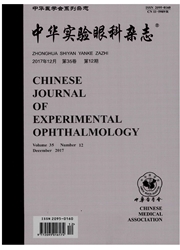

 中文摘要:
中文摘要:
背景 眼内炎是多种内眼手术的严重并发症,以往感染菌的确定多采用细菌培养和涂片染色法,但存在花费时间长和阳性率低的问题.16S rDNA是细菌染色体上编码rRNA的序列,利用16S rDNA分子测序技术检测细菌具有高度的特异性. 目的 利用16S rDNA测序技术对细菌性眼内炎房水和/或玻璃体标本中的感染菌进行鉴定,探讨该技术在眼部感染性炎症诊断中的作用.方法 收集2015年6-12月在青岛眼科医院临床诊断为细菌性眼内炎的患者5例5眼,抽取每例患者的房水0.1~0.2 ml或玻璃标体标本0.5 ~1.0ml,各取50 μl用于高通量测序,剩余标本行涂片检查和细菌培养.采用D3096-01微量DNA试剂盒提取标本中细菌DNA,对收集的标本DNA样品进行16S rRNA基因V3-V4区PCR扩增,应用MiSeq 300测序仪对扩增的16S rDNA高变区序列进行测序,分析标本中病原菌的分类组成、分布特点以及各病原菌在标本中的相对含量,取50 μl无RNA酶水于一次性无菌离心管内作为空白对照. 结果 共收集到5份房水或玻璃体标本,涂片染色结果阳性者2例,外伤性细菌性眼内炎为革兰阳性杆菌,滤过泡感染性细菌性眼内炎为革兰阴性杆菌,而细菌培养法结果均为阴性.16S rDNA测序技术发现,5例标本检测阳性率为100%.外伤性细菌性眼内炎标本中高丰度菌属为葡萄球菌属、链球菌属和假单胞菌属,分别占65.28%、18.90%和12.76%;白内障术后2d急性细菌性眼内炎患眼标本中高丰度菌属有假单胞菌属、不动杆菌属和Limnobacter菌属,分别占53.68%、8.62%和5.96%;滤过泡感染性细菌性眼内炎标本中高丰度菌属有莫拉菌属和假单胞菌属,分别占88.89%和9.52%;白内障术后22 d迟发性细菌性眼内炎标本中相对含量较高的菌属有假单胞菌属,占84.63%;白内障术后1d急性细菌性眼内炎患眼标本中相对含量较高的有假单胞菌属,占97.89%.结论 16S rDNA测序可准确鉴别眼?
 英文摘要:
英文摘要:
Background Endophthalmitis is a serious complication of intraocular surgery.Conventional identification methods for bacteria are becterial culture and smear method,but these laboratory tests spend a long time and have low positive rates.16S rDNA is the bacterial chromosome encoding ribosomal RNA sequences,and it is determined that 16S rDNA sequencing has a high specificity for the identification of bacteria.Objective This study was to identify the infectious bacteria from aqueous humor or vitreous body in the eyes with endophthalmitis by 16S rDNA sequencing technique,and to investigate the diagnosis efficency of 16S rDNA sequencing technique on bacterial endophthalmitis.Methods Anterior chamber fluid (0.1-0.2 ml) or vitreous humor (0.5-1.0 ml) specimens were collected from 5 eyes of 5 patients with endophthalmitis in Qingdao Eye Hospital from June to December 2015 and used for high throughput sequencing,bacterial culture and smear,respectively.Bacteria DNA was extracted from the specimen with D3096-01 trace DNA kit for the amplification of V3-V4 region of 16S rRNA gene and sequencing of hypervariable region of all microbes in the samples by MiSeq Illumina Sequencing Platform.Then the bioinformatic analysis including analysis of taxonomy,abundance and alpha diversity were performed.Nucleasefree water of 50 μl in the centrifuge tube was used as control.Results Five aqueous humor or vitreous body samples were collected,and the positive results were exhibited by smear examination,with the Gram positive bacilli in the trumatic endophthalmitis eye and Gram negative bacilli in the filtering bleb infectious endophthalmitis eye,and all culture results were negative.16S rDNA squencing showed the positive outcomes in all the 5 samples.The high abundent nacteral genuses were Staphylococcus (65.28%),Streptococcus (18.90%) and Pseudomonas (12.76%) in the trumatic endophthalmitis eye;the major components of sample were Pseudomonas (53.68%),Acinetobacter (8.62%) and Limnobacter (5.96%) in the eye
 同期刊论文项目
同期刊论文项目
 同项目期刊论文
同项目期刊论文
 期刊信息
期刊信息
